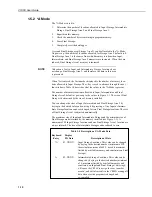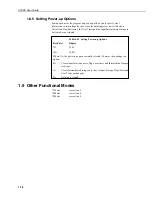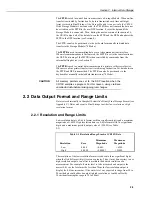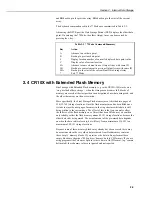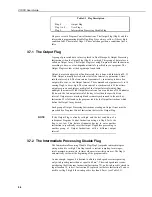
Section 2. Internal Data Storage
2-5
and
#B
backs up to the previous array.
#0A
backs up to the start of the current
array.
The keyboard commands used in the *7 Mode are summarised in Table 2-2.
Advancing the DPTR past the Data Storage Pointer (DSP) displays the oldest data
point. On entering the *7 Mode, the oldest Output Array can be accessed by
pressing the
A
key.
Table 2-2 *7 Mode Command Summary
Key
Action
A
Advance to next data point
B
Back up to previous data point
#
Display location number of currently displayed data point value
C
Display value of current location
#A
Advance to same element in next Output Array with same ID
#B
Back up to same element in previous Output Array with same ID
#0A
Back up to the start of the current Final Data Storage Array
*
Exit *7 Mode
2.4 CR10X with Extended Flash Memory
Final storage with Extended Flash memory (e.g. in the CR10X-1M) works on a
‘ring’ method of data storage – when the storage area becomes full, blocks of
memory are erased at the start position in anticipation of new data being read, and
the oldest data areas are then overwritten.
More specifically, the Final Storage Flash memory area is divided into pages of
32k (32,768) storage locations. Once the flash memory area has been filled once,
it starts to erase the next page of memory in the ring structure while data is still
being written to the current page. The effect of this is that you can only collect
the full size of the flash memory once. After it has been filled once you can then
only reliably collect the flash memory minus 49,151 storage locations, because the
oldest data risks being erased. The actual amount of the pre-erased data depends
on when the data retrieval occurs, but will vary from a minimum of 16,383 to a
maximum of 49,151 storage locations.
Because some of these memory blocks may already have been erased, there may
be occasions when the very oldest data retrieved from flash memory contains
these ‘empty’ memory blocks. If you retrieve the data in binary format these
empty blocks are shown as 7F00 entries (‘dummy’ data in CSI format). If you are
using programs like Telcom or Split to retrieve data in ASCII format, (e.g. comma
delineated), these dummy values are ignored and not reported.


